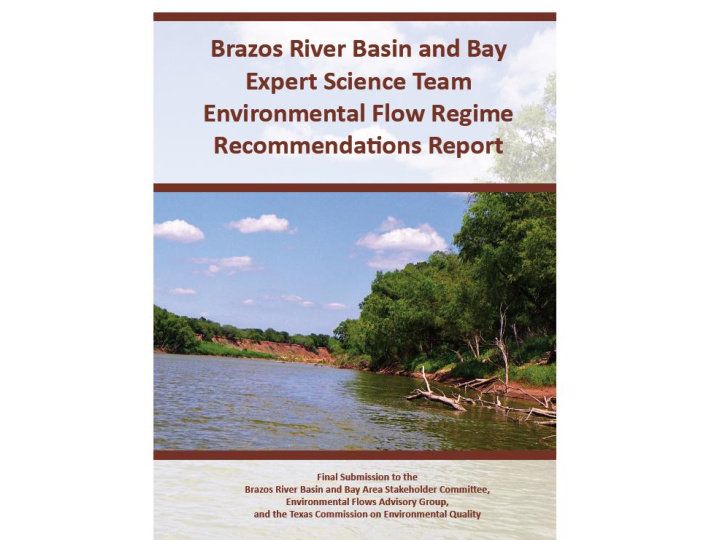



4,000-10,000 cfs for 2-3 days Once every 3-5 years Channel maintenance Floodplain connectivity,Seed dispersal 300-450 cfs Maintain biodiversity and longitudinal connectivity
Upper Brazos River (confluence of Salt Fork and Double Mountain Fork to Possum Kingdom Lake): High fish assemblage integrity: dominated by a few, fluvial specialist taxa that are adapted to the variable and sometime extreme conditions of this region.
Upper Brazos River (confluence of Salt Fork and Double Mountain Fork to Possum Kingdom Lake): High fish assemblage integrity: dominated by a few, fluvial specialist taxa that are adapted to the variable and sometime extreme conditions of this region. sharpnose shiner smalleye shiner Photos from Chad Thomas. Texas State Univ.
Annear, T. I. Chisholm, H. Beecher, A. Locke, and 12 other authors. 2004. Instream Flows for Riverine Resource Stewardship, Revised Edition . Instream Flow Council, Cheyenne, WY. This book lists dozens of methods – their intended uses and potential abuses.
For its evaluations and analyses, the Brazos BBEST used: 1. Indicators of Hydrologic Alteration Method – provides ecologists and hydrologists with a tool to characterize and compare complex hydrologic regimes in ecologically meaningful terms. 2. Target Fish Community Assessment – describes a model fish community that serves as a target for river restoration, rehabilitation, or enhancement and as an endpoint for evaluating program success. 3. Biological Response to Flow Correlation Method – identifies correlations between biological response or habitat condition and flow-related variables. 4. Floodplain Inundation Method – determines flows to protect aquatic, riparian, wetland, and floodplain resources or compare alternative flow regimes. • No study results were available from IFIM , PHabSim or MesoHabSim methods. The BBEST also evaluated: 5. Water quality in relation to discharge 6. Sediment transport in relation to flow regimes (Flushing flow: empirical, sediment transport modeling, and ‘desktop’ hydrologic methods) 7. Estuarine inflows, salinity, and potential responses of coastal marine organisms (indicator taxa)
Research findings specifically useful for evaluation of Upper Brazos River near Seymour Conner, J.V. and R.D. Suttkus. 1986. Zoogeography of freshwater fishes of the western Gulf slope. Pages 413-456 in C.H. Hocutt and E.O. Wiley, Editors. The Zoogeography of North American Freshwater Fishes . Wiley, New York. Craven, S.W., J.T. Peterson, M.C. Freeman, T.J. Kwak, and E. Irwin. 2010. Modeling the relations between flow regime components, species traits, and spawning success of fishes in warmwater streams. Environmental Management 46:181-194. Durham, B.W. and G.R. Wilde. 2006. Influence of stream discharge on reproductive success of a prairie stream fish assemblage. Transactions of the American Fisheries Society 135:1644-1653. Durham, B.W. and G.R. Wilde. 2006. Asynchronous and synchrounous spawning by smalleye shiner Notoropis buccula from the Brazos River, Texas. Ecology of Freshwater Fish 17:528-541. Durham, B.W. and G.R. Wilde. 2009a. Effects of streamflow and intermittency on the reproductive success of two broadcast-spawning cyprinid fishes. Copeia 2009:21-28. Durham, B.W. and G.R. Wilde. 2009b. Population dynamics of the smalleye shiner, an imperiled cyprinid fish endemic to the Brazos River, Texas. Transactions of the American Fisheries Society 138:666-674. Howells, R.G., R.W. Neck, and H.D. Murray. 1996. Freshwater Mussels of Texas . Texas Parks and Wildlife Press, Austin, TX, 224 pp. Hubbs, C., R.J. Edwards, and G.P. Garrett. 2008. An annotated checklist of the freshwater fishes of Texas, with keys to identification of species. Texas Journal of Science, Supplement 43(4):1-56. Perkin, J.S., C.S. Williams, and T.H. Bonner. 2009. Aspects of chub shiner Notropis potteri life history with comments on native distribution and conservation status. American Midland Naturalist 162:276-288. Perkin, J.S. and K.B. Gido. 2011. Stream fragmentation thresholds for a reproductive guild of Great Plains fishes. Fisheries 36:371-383. Rees, D.E., R.J. Carr, and W.J. Miller. (2005). Plains Minnow ( Hybognathus placitus ): A Technical Conservation Assessment . [Online]. USDA Forest Service, Rocky Mountain Region. Wilde, G.R. and B.W. Durham. 2008. A life history model for peppered chub, a broadcast-spawning cyprinid. Transactions of the American Fisheries Society 137:1657-1666.
Brazos River at Seymour
Moehlman’s Slough, oxbow in Burleson co.
_________________________________________________________ Flow to Connect Number of Connections Oxbow (cfs) 1984-1994 1994-2004 _________________________________________________________ Hog Island 3,625 61 68 Big Bend 20,000 32 41 Korthauer Bottom 20,500 32 50 Moehlman Slough 45,000 14 12 Cutoff Lake 76,200 2 3 Horseshoe Lake 99,000 1 0 _________________________________________________________
Structure of river channel and oxbow lake fish assemblages oxbow samples river samples CA using seine CPUE data for fishes
During floods there is exchange of fishes between river and oxbows flood periods oxbow samples river samples CA using seine CPUE data for fishes
Lower Brazos River (reach below the mouth of the Bosque River to the coast) : Moderate fish assemblage integrity; the majority of the fish community remains intact. Loss of at least one fluvial specialist (smalleye shiner, Notropis buccula ) and declines in populations of several other fluvial specialists and increases in abundance of habitat generalists, such as bluegill sunfish ( Lepomis macrochirus ), suggest community changes associated with flow modifications.
Recommend
More recommend